stop start Ram ProMaster City 2016 Owner's Manual
[x] Cancel search | Manufacturer: RAM, Model Year: 2016, Model line: ProMaster City, Model: Ram ProMaster City 2016Pages: 438, PDF Size: 3.26 MB
Page 14 of 438
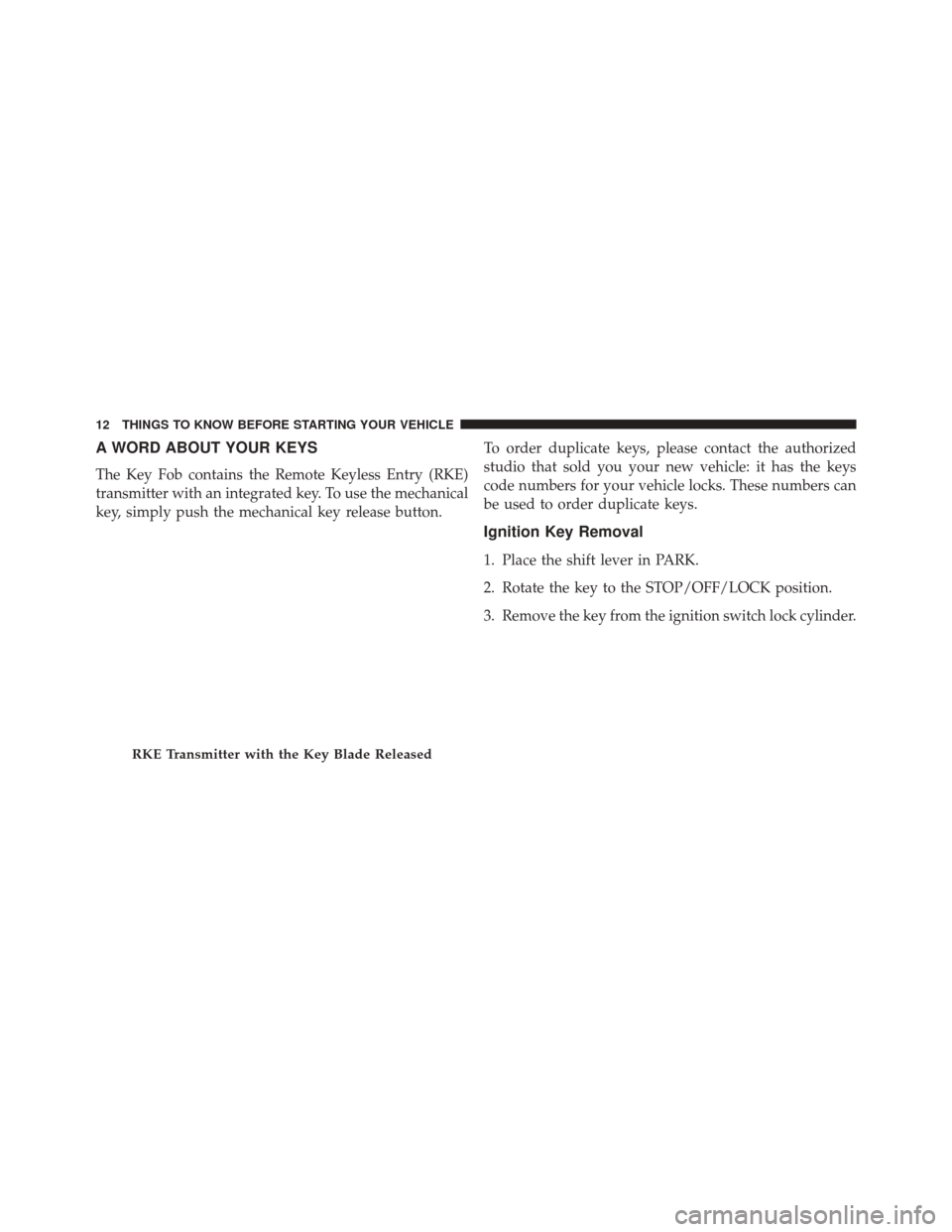
A WORD ABOUT YOUR KEYS
The Key Fob contains the Remote Keyless Entry (RKE)
transmitter with an integrated key. To use the mechanical
key, simply push the mechanical key release button.To order duplicate keys, please contact the authorized
studio that sold you your new vehicle: it has the keys
code numbers for your vehicle locks. These numbers can
be used to order duplicate keys.
Ignition Key Removal
1. Place the shift lever in PARK.
2. Rotate the key to the STOP/OFF/LOCK position.
3. Remove the key from the ignition switch lock cylinder.
RKE Transmitter with the Key Blade Released
12 THINGS TO KNOW BEFORE STARTING YOUR VEHICLE
Page 15 of 438
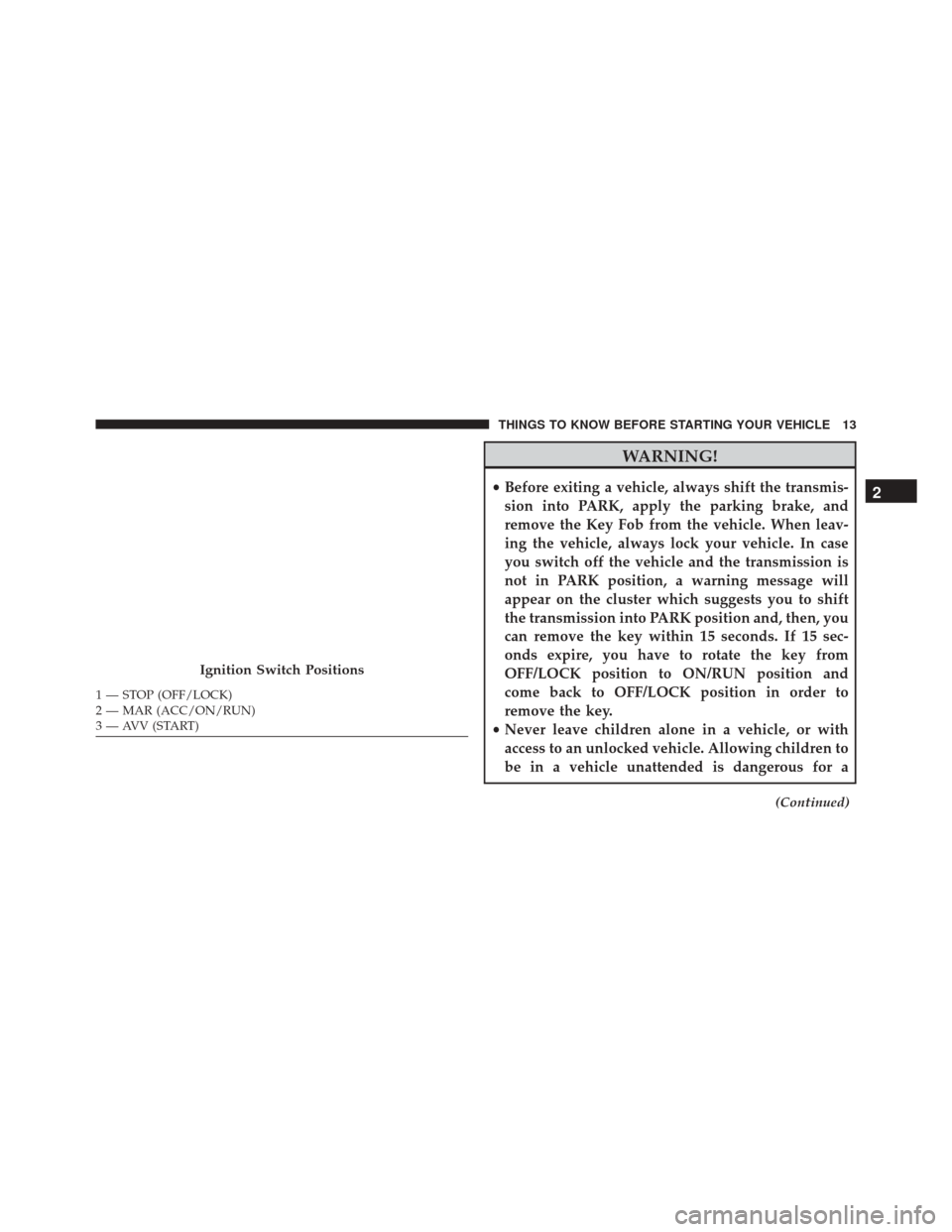
WARNING!
•Before exiting a vehicle, always shift the transmis-
sion into PARK, apply the parking brake, and
remove the Key Fob from the vehicle. When leav-
ing the vehicle, always lock your vehicle. In case
you switch off the vehicle and the transmission is
not in PARK position, a warning message will
appear on the cluster which suggests you to shift
the transmission into PARK position and, then, you
can remove the key within 15 seconds. If 15 sec-
onds expire, you have to rotate the key from
OFF/LOCK position to ON/RUN position and
come back to OFF/LOCK position in order to
remove the key.
• Never leave children alone in a vehicle, or with
access to an unlocked vehicle. Allowing children to
be in a vehicle unattended is dangerous for a
(Continued)
Ignition Switch Positions
1 — STOP (OFF/LOCK)
2 — MAR (ACC/ON/RUN)
3 — AVV (START)
2
THINGS TO KNOW BEFORE STARTING YOUR VEHICLE 13
Page 29 of 438
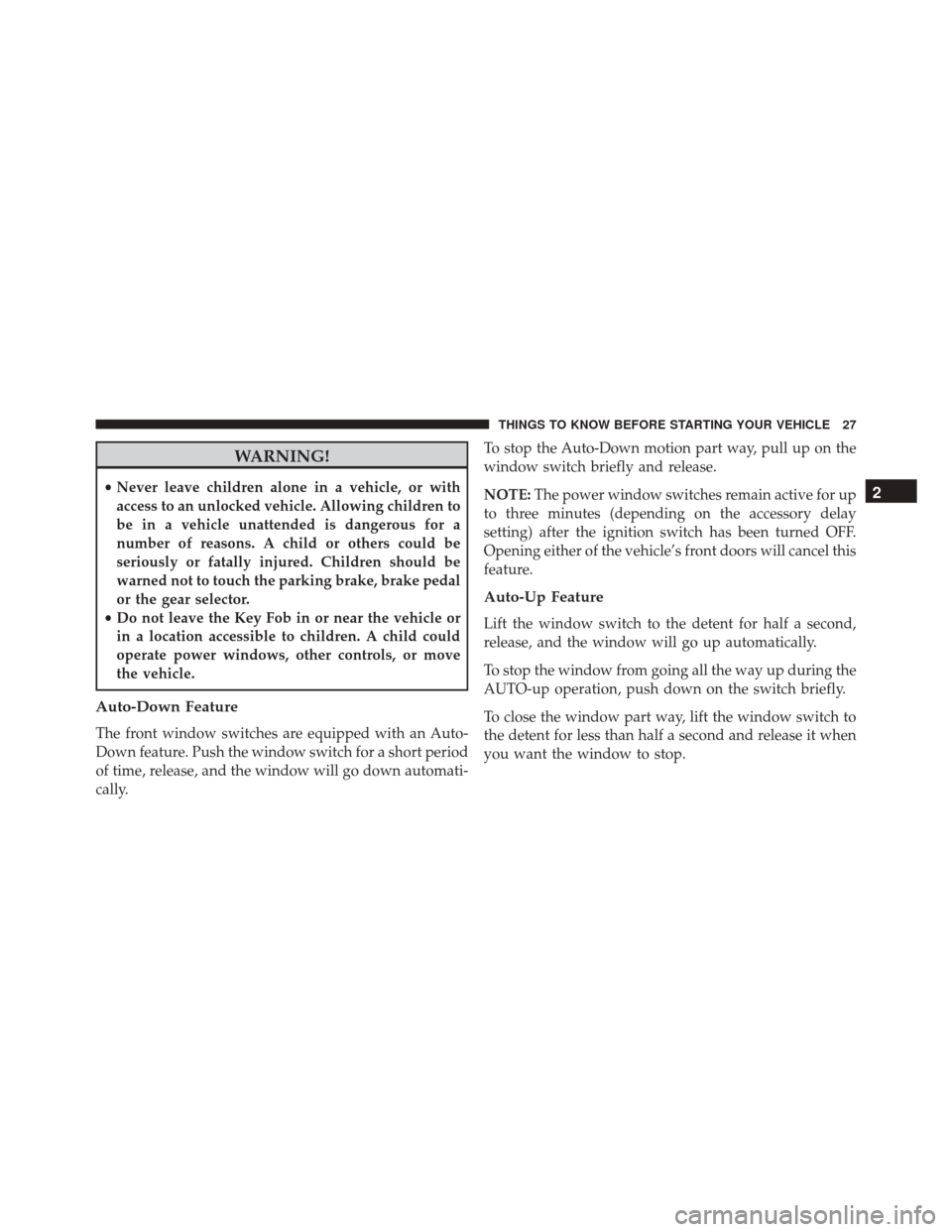
WARNING!
•Never leave children alone in a vehicle, or with
access to an unlocked vehicle. Allowing children to
be in a vehicle unattended is dangerous for a
number of reasons. A child or others could be
seriously or fatally injured. Children should be
warned not to touch the parking brake, brake pedal
or the gear selector.
• Do not leave the Key Fob in or near the vehicle or
in a location accessible to children. A child could
operate power windows, other controls, or move
the vehicle.
Auto-Down Feature
The front window switches are equipped with an Auto-
Down feature. Push the window switch for a short period
of time, release, and the window will go down automati-
cally. To stop the Auto-Down motion part way, pull up on the
window switch briefly and release.
NOTE:
The power window switches remain active for up
to three minutes (depending on the accessory delay
setting) after the ignition switch has been turned OFF.
Opening either of the vehicle’s front doors will cancel this
feature.
Auto-Up Feature
Lift the window switch to the detent for half a second,
release, and the window will go up automatically.
To stop the window from going all the way up during the
AUTO-up operation, push down on the switch briefly.
To close the window part way, lift the window switch to
the detent for less than half a second and release it when
you want the window to stop.
2
THINGS TO KNOW BEFORE STARTING YOUR VEHICLE 27
Page 31 of 438
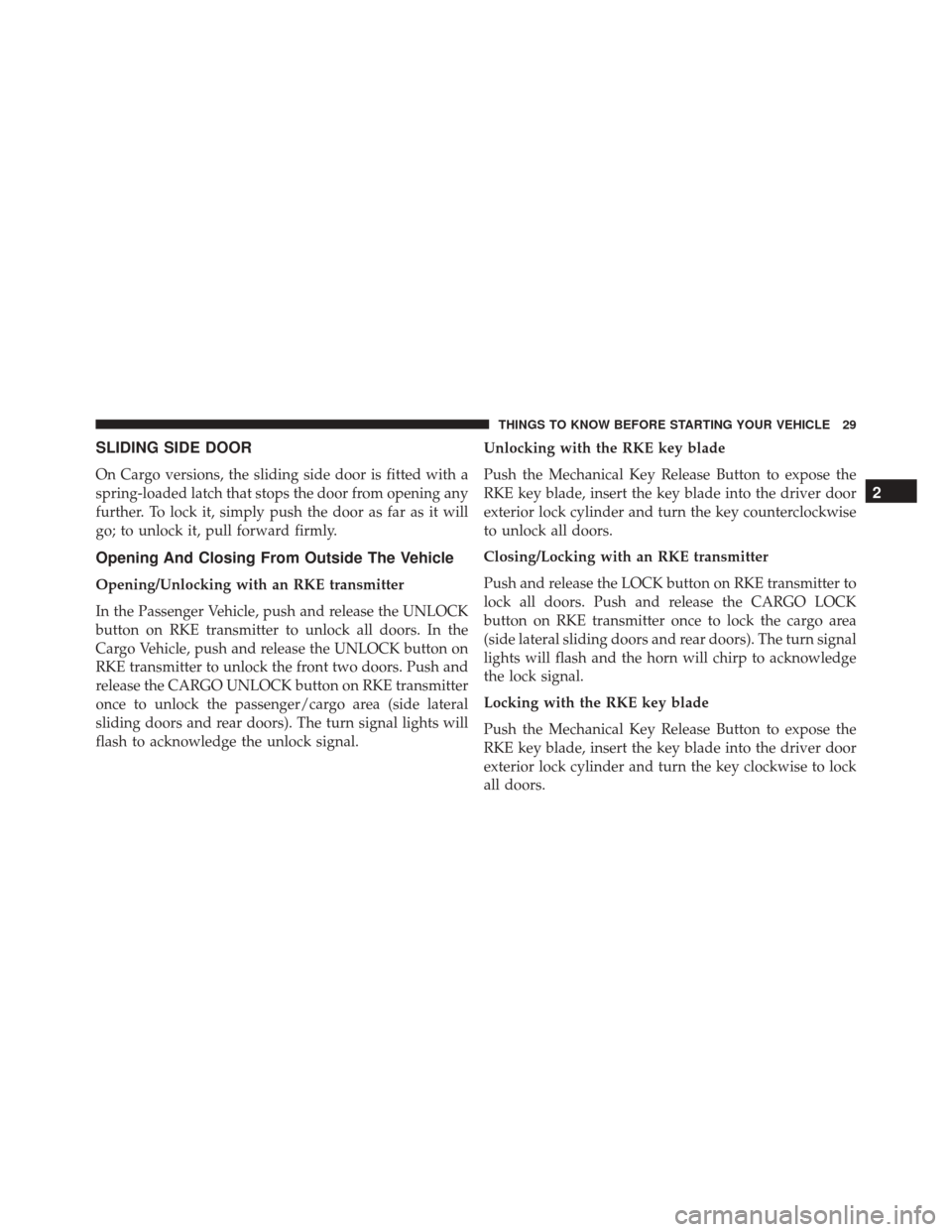
SLIDING SIDE DOOR
On Cargo versions, the sliding side door is fitted with a
spring-loaded latch that stops the door from opening any
further. To lock it, simply push the door as far as it will
go; to unlock it, pull forward firmly.
Opening And Closing From Outside The Vehicle
Opening/Unlocking with an RKE transmitter
In the Passenger Vehicle, push and release the UNLOCK
button on RKE transmitter to unlock all doors. In the
Cargo Vehicle, push and release the UNLOCK button on
RKE transmitter to unlock the front two doors. Push and
release the CARGO UNLOCK button on RKE transmitter
once to unlock the passenger/cargo area (side lateral
sliding doors and rear doors). The turn signal lights will
flash to acknowledge the unlock signal.Unlocking with the RKE key blade
Push the Mechanical Key Release Button to expose the
RKE key blade, insert the key blade into the driver door
exterior lock cylinder and turn the key counterclockwise
to unlock all doors.
Closing/Locking with an RKE transmitter
Push and release the LOCK button on RKE transmitter to
lock all doors. Push and release the CARGO LOCK
button on RKE transmitter once to lock the cargo area
(side lateral sliding doors and rear doors). The turn signal
lights will flash and the horn will chirp to acknowledge
the lock signal.
Locking with the RKE key blade
Push the Mechanical Key Release Button to expose the
RKE key blade, insert the key blade into the driver door
exterior lock cylinder and turn the key clockwise to lock
all doors.
2
THINGS TO KNOW BEFORE STARTING YOUR VEHICLE 29
Page 33 of 438
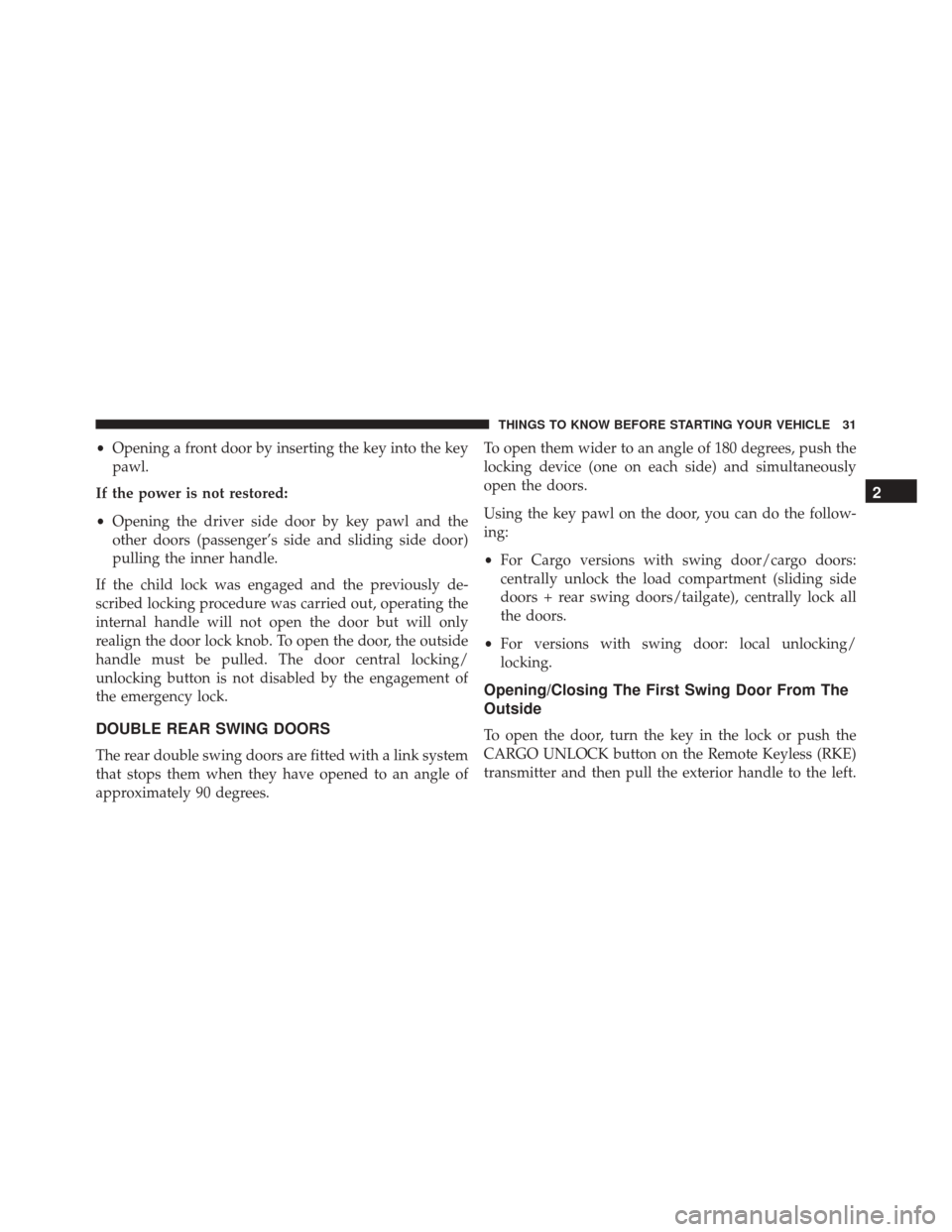
•Opening a front door by inserting the key into the key
pawl.
If the power is not restored:
• Opening the driver side door by key pawl and the
other doors (passenger’s side and sliding side door)
pulling the inner handle.
If the child lock was engaged and the previously de-
scribed locking procedure was carried out, operating the
internal handle will not open the door but will only
realign the door lock knob. To open the door, the outside
handle must be pulled. The door central locking/
unlocking button is not disabled by the engagement of
the emergency lock.
DOUBLE REAR SWING DOORS
The rear double swing doors are fitted with a link system
that stops them when they have opened to an angle of
approximately 90 degrees. To open them wider to an angle of 180 degrees, push the
locking device (one on each side) and simultaneously
open the doors.
Using the key pawl on the door, you can do the follow-
ing:
•
For Cargo versions with swing door/cargo doors:
centrally unlock the load compartment (sliding side
doors + rear swing doors/tailgate), centrally lock all
the doors.
• For versions with swing door: local unlocking/
locking.
Opening/Closing The First Swing Door From The
Outside
To open the door, turn the key in the lock or push the
CARGO UNLOCK button on the Remote Keyless (RKE)
transmitter and then pull the exterior handle to the left.
2
THINGS TO KNOW BEFORE STARTING YOUR VEHICLE 31
Page 38 of 438
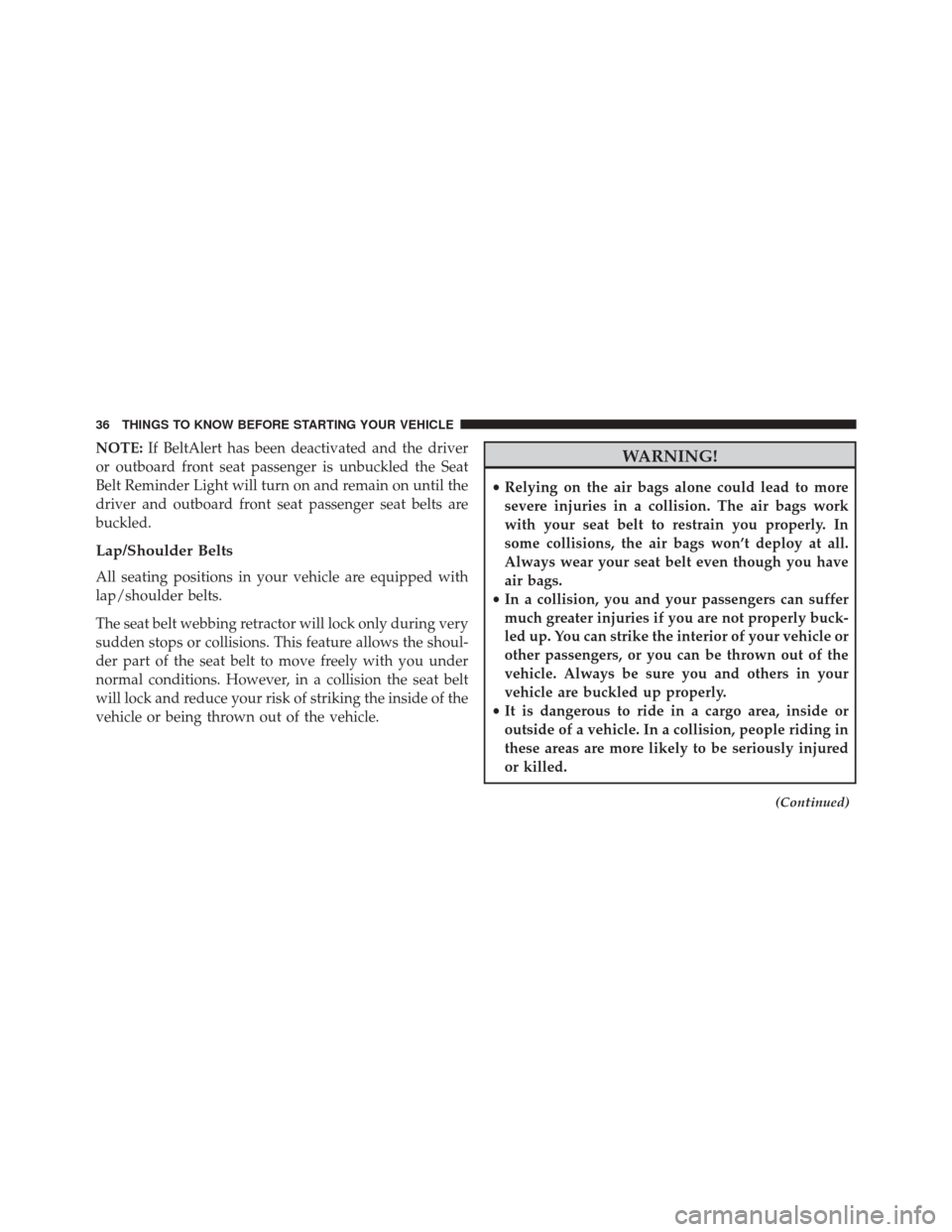
NOTE:If BeltAlert has been deactivated and the driver
or outboard front seat passenger is unbuckled the Seat
Belt Reminder Light will turn on and remain on until the
driver and outboard front seat passenger seat belts are
buckled.
Lap/Shoulder Belts
All seating positions in your vehicle are equipped with
lap/shoulder belts.
The seat belt webbing retractor will lock only during very
sudden stops or collisions. This feature allows the shoul-
der part of the seat belt to move freely with you under
normal conditions. However, in a collision the seat belt
will lock and reduce your risk of striking the inside of the
vehicle or being thrown out of the vehicle.
WARNING!
• Relying on the air bags alone could lead to more
severe injuries in a collision. The air bags work
with your seat belt to restrain you properly. In
some collisions, the air bags won’t deploy at all.
Always wear your seat belt even though you have
air bags.
• In a collision, you and your passengers can suffer
much greater injuries if you are not properly buck-
led up. You can strike the interior of your vehicle or
other passengers, or you can be thrown out of the
vehicle. Always be sure you and others in your
vehicle are buckled up properly.
• It is dangerous to ride in a cargo area, inside or
outside of a vehicle. In a collision, people riding in
these areas are more likely to be seriously injured
or killed.
(Continued)
36 THINGS TO KNOW BEFORE STARTING YOUR VEHICLE
Page 40 of 438
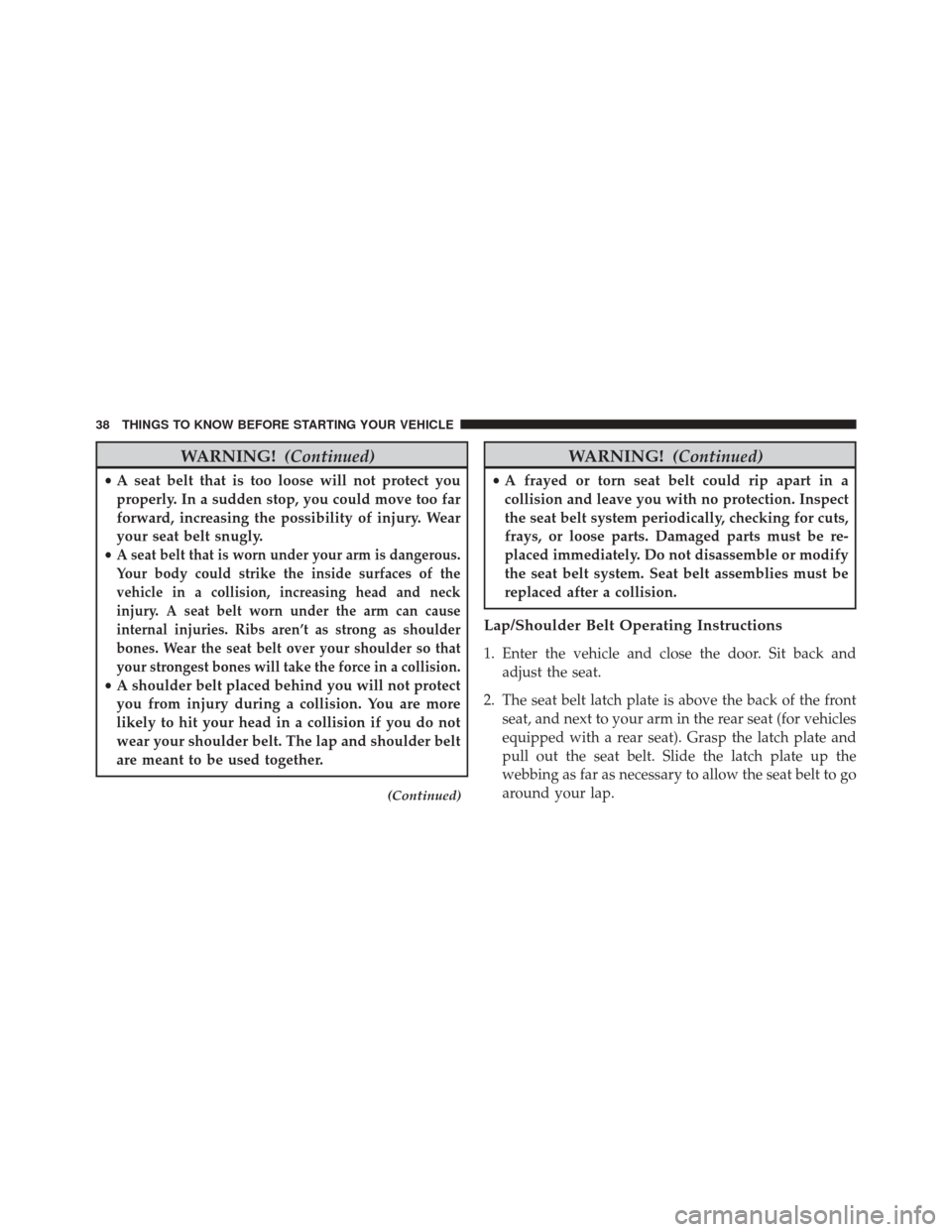
WARNING!(Continued)
•A seat belt that is too loose will not protect you
properly. In a sudden stop, you could move too far
forward, increasing the possibility of injury. Wear
your seat belt snugly.
•
A seat belt that is worn under your arm is dangerous.
Your body could strike the inside surfaces of the
vehicle in a collision, increasing head and neck
injury. A seat belt worn under the arm can cause
internal injuries. Ribs aren’t as strong as shoulder
bones. Wear the seat belt over your shoulder so that
your strongest bones will take the force in a collision.
• A shoulder belt placed behind you will not protect
you from injury during a collision. You are more
likely to hit your head in a collision if you do not
wear your shoulder belt. The lap and shoulder belt
are meant to be used together.
(Continued)
WARNING! (Continued)
•A frayed or torn seat belt could rip apart in a
collision and leave you with no protection. Inspect
the seat belt system periodically, checking for cuts,
frays, or loose parts. Damaged parts must be re-
placed immediately. Do not disassemble or modify
the seat belt system. Seat belt assemblies must be
replaced after a collision.
Lap/Shoulder Belt Operating Instructions
1. Enter the vehicle and close the door. Sit back and adjust the seat.
2. The seat belt latch plate is above the back of the front seat, and next to your arm in the rear seat (for vehicles
equipped with a rear seat). Grasp the latch plate and
pull out the seat belt. Slide the latch plate up the
webbing as far as necessary to allow the seat belt to go
around your lap.
38 THINGS TO KNOW BEFORE STARTING YOUR VEHICLE
Page 59 of 438
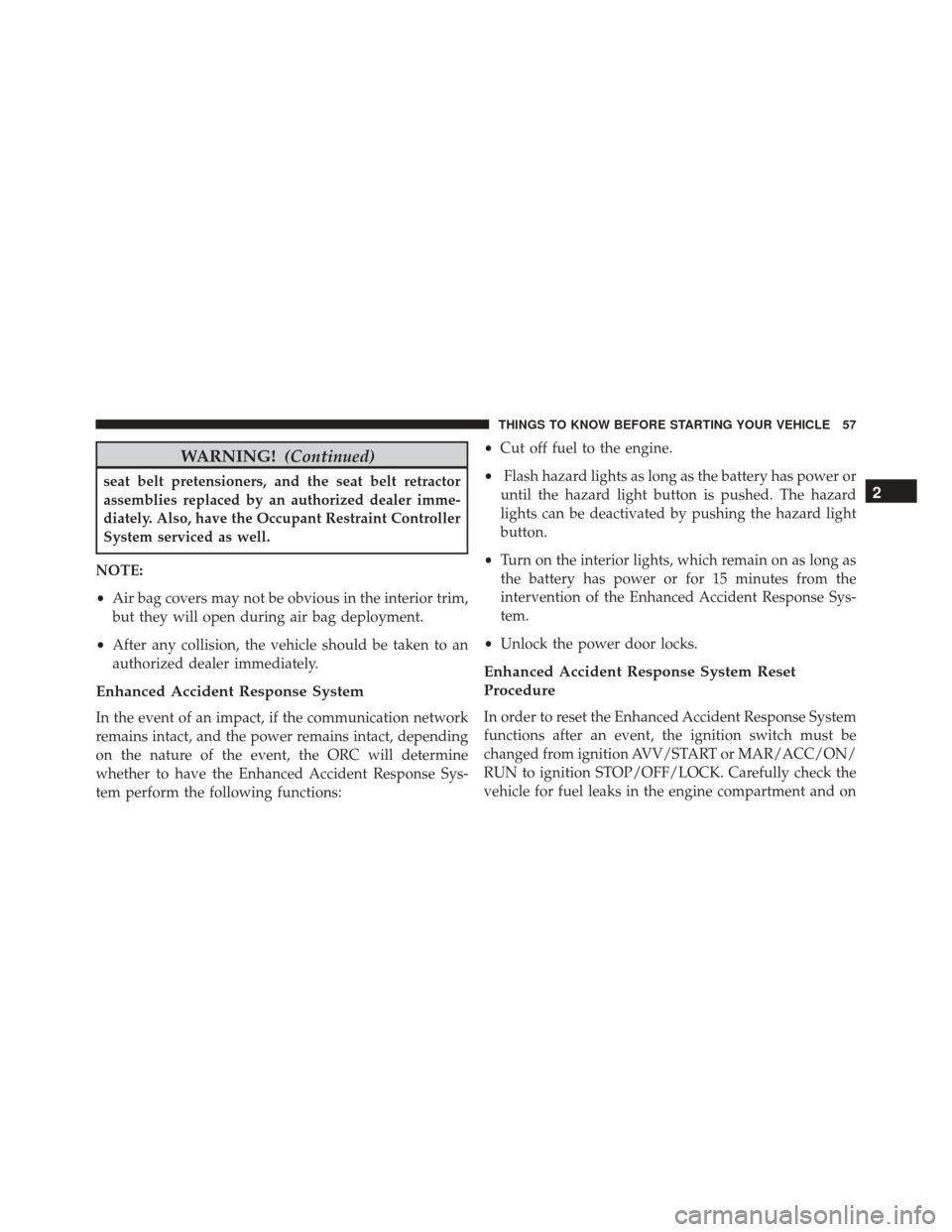
WARNING!(Continued)
seat belt pretensioners, and the seat belt retractor
assemblies replaced by an authorized dealer imme-
diately. Also, have the Occupant Restraint Controller
System serviced as well.
NOTE:
• Air bag covers may not be obvious in the interior trim,
but they will open during air bag deployment.
• After any collision, the vehicle should be taken to an
authorized dealer immediately.
Enhanced Accident Response System
In the event of an impact, if the communication network
remains intact, and the power remains intact, depending
on the nature of the event, the ORC will determine
whether to have the Enhanced Accident Response Sys-
tem perform the following functions: •
Cut off fuel to the engine.
• Flash hazard lights as long as the battery has power or
until the hazard light button is pushed. The hazard
lights can be deactivated by pushing the hazard light
button.
• Turn on the interior lights, which remain on as long as
the battery has power or for 15 minutes from the
intervention of the Enhanced Accident Response Sys-
tem.
• Unlock the power door locks.
Enhanced Accident Response System Reset
Procedure
In order to reset the Enhanced Accident Response System
functions after an event, the ignition switch must be
changed from ignition AVV/START or MAR/ACC/ON/
RUN to ignition STOP/OFF/LOCK. Carefully check the
vehicle for fuel leaks in the engine compartment and on
2
THINGS TO KNOW BEFORE STARTING YOUR VEHICLE 57
Page 60 of 438
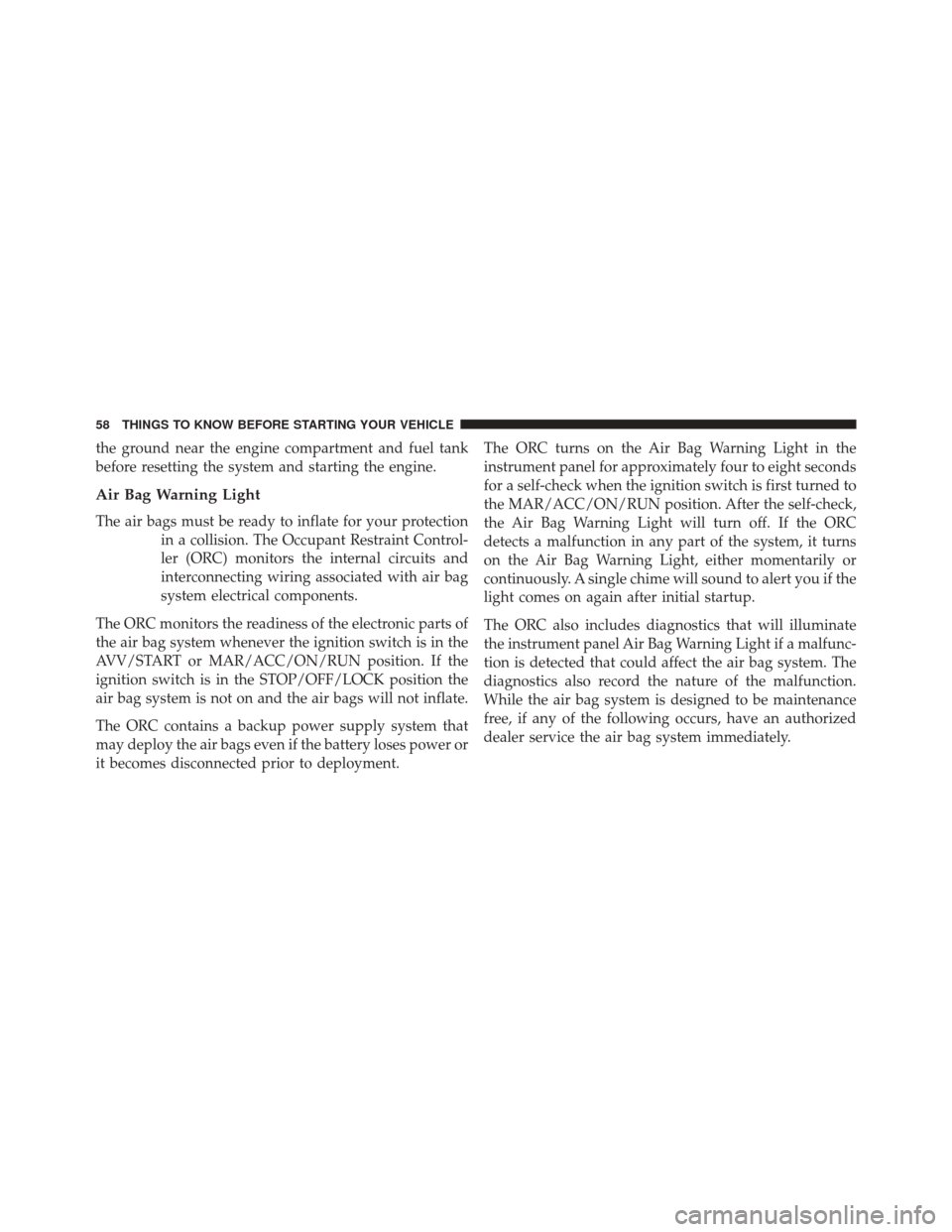
the ground near the engine compartment and fuel tank
before resetting the system and starting the engine.
Air Bag Warning Light
The air bags must be ready to inflate for your protectionin a collision. The Occupant Restraint Control-
ler (ORC) monitors the internal circuits and
interconnecting wiring associated with air bag
system electrical components.
The ORC monitors the readiness of the electronic parts of
the air bag system whenever the ignition switch is in the
AVV/START or MAR/ACC/ON/RUN position. If the
ignition switch is in the STOP/OFF/LOCK position the
air bag system is not on and the air bags will not inflate.
The ORC contains a backup power supply system that
may deploy the air bags even if the battery loses power or
it becomes disconnected prior to deployment. The ORC turns on the Air Bag Warning Light in the
instrument panel for approximately four to eight seconds
for a self-check when the ignition switch is first turned to
the MAR/ACC/ON/RUN position. After the self-check,
the Air Bag Warning Light will turn off. If the ORC
detects a malfunction in any part of the system, it turns
on the Air Bag Warning Light, either momentarily or
continuously. A single chime will sound to alert you if the
light comes on again after initial startup.
The ORC also includes diagnostics that will illuminate
the instrument panel Air Bag Warning Light if a malfunc-
tion is detected that could affect the air bag system. The
diagnostics also record the nature of the malfunction.
While the air bag system is designed to be maintenance
free, if any of the following occurs, have an authorized
dealer service the air bag system immediately.
58 THINGS TO KNOW BEFORE STARTING YOUR VEHICLE
Page 67 of 438
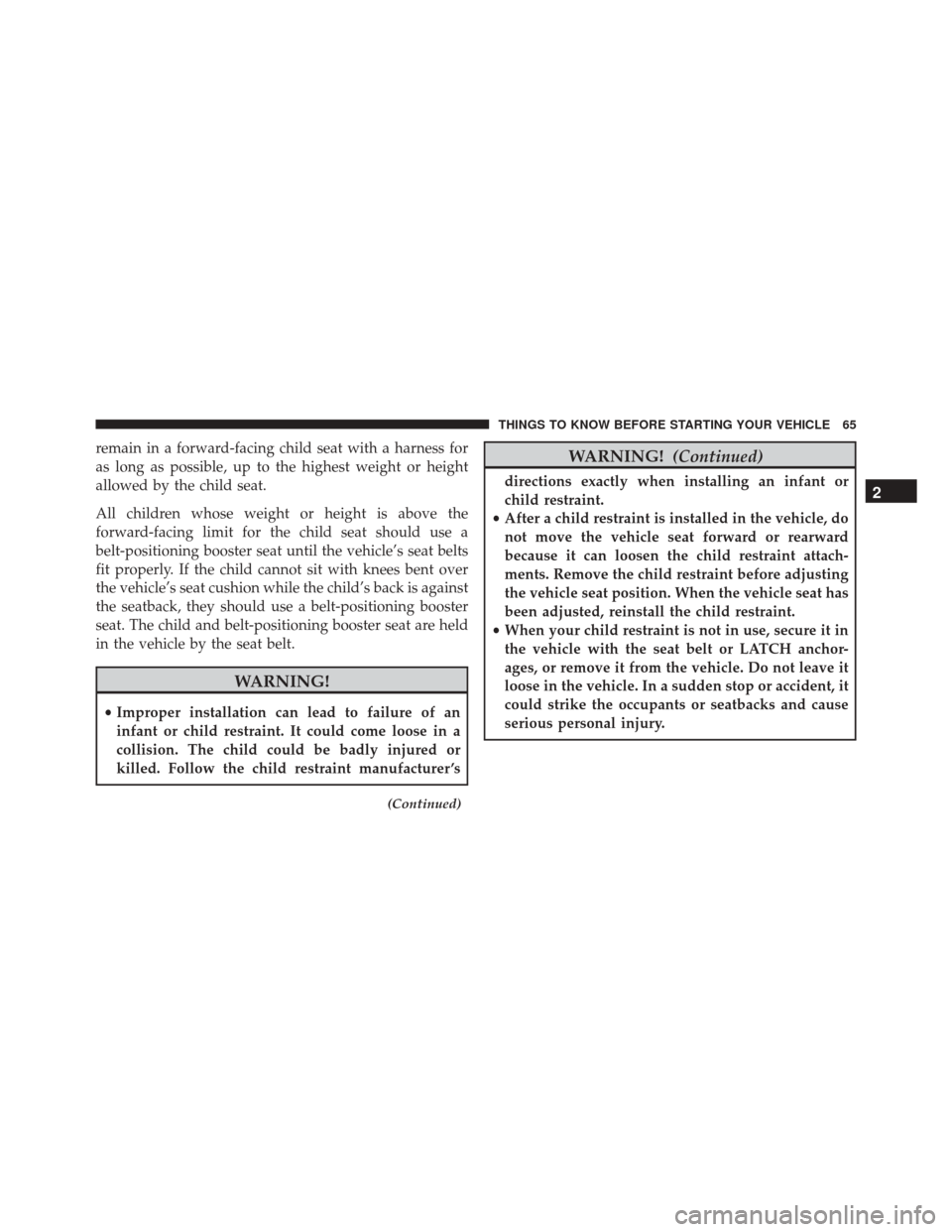
remain in a forward-facing child seat with a harness for
as long as possible, up to the highest weight or height
allowed by the child seat.
All children whose weight or height is above the
forward-facing limit for the child seat should use a
belt-positioning booster seat until the vehicle’s seat belts
fit properly. If the child cannot sit with knees bent over
the vehicle’s seat cushion while the child’s back is against
the seatback, they should use a belt-positioning booster
seat. The child and belt-positioning booster seat are held
in the vehicle by the seat belt.
WARNING!
•Improper installation can lead to failure of an
infant or child restraint. It could come loose in a
collision. The child could be badly injured or
killed. Follow the child restraint manufacturer ’s
(Continued)
WARNING! (Continued)
directions exactly when installing an infant or
child restraint.
• After a child restraint is installed in the vehicle, do
not move the vehicle seat forward or rearward
because it can loosen the child restraint attach-
ments. Remove the child restraint before adjusting
the vehicle seat position. When the vehicle seat has
been adjusted, reinstall the child restraint.
• When your child restraint is not in use, secure it in
the vehicle with the seat belt or LATCH anchor-
ages, or remove it from the vehicle. Do not leave it
loose in the vehicle. In a sudden stop or accident, it
could strike the occupants or seatbacks and cause
serious personal injury.2
THINGS TO KNOW BEFORE STARTING YOUR VEHICLE 65